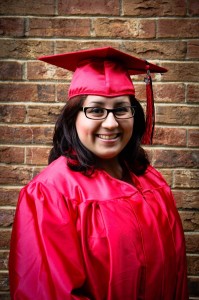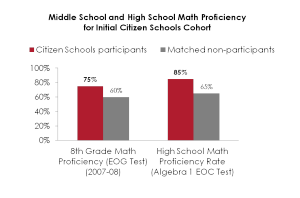Longitudinal Study Shows Promising Results in Charlotte
Think back to your first day of 6th grade. You were probably brand new to middle school–trying to find your classrooms, looking for familiar faces, trying not to get squashed by one of the big 8th graders. Six years ago, Mary Espinosa was one of those kids. But she wasn't just any new middle schooler. She came from an immigrant family that was brand new to Charlotte, North Carolina and starting middle school in an unfamiliar, lower-income neighborhood.
After a year of making new friends and meeting students from Spanish speaking households, one- parent households and all types of families, she joined a program called Citizen Schools in 7th grade. Her experiences there helped shape her trajectory–and that of her peers.
Citizen Schools was also brand new to Charlotte when Mary signed up, and its leadership hoped that its model would be as transformative here as it had been in Boston, where it was founded in 1995. The district, Charlotte-Mecklenburg Schools (CMS), has defined its goal of achieving a 90% high school graduation rate by 2014 (compared to 75% in 2012). To accomplish that, it partners with a variety of programs. Citizen Schools is one.
Mary and her fellow Eastway Middle School students stayed after school to experience academic support, caring mentors, and Citizen Schools’ signature enrichment opportunities–apprenticeships. Professionals from community companies like Bank of America, Wells Fargo, and Microsoft come to the schools to lead projects in a range of skills, helping kids discover new career paths and set goals for the next stage of their lives.
Now, the question for Citizen Schools and the district is “Did it work?” Can we tell if participating in a given program has had an impact on children’s lives, and how long does that impact last?
Answering this notoriously difficult question requires investing in a rigorous form of evaluation called a longitudinal study. Citizen Schools looked at its oldest cohort of alumni in Charlotte and their peers–more than 600 students. With additional data provided by CMS, we were then able to match the Citizen Schools participants to peers who were similar to them demographically but did not participate in the Citizen Schools program. This gave us the opportunity to measure the impact of Citizen Schools during middle school, as well as to and through high school.
Here’s what we learned.
Engagement and Achievement
Overall, across all cohorts, Citizen Schools participants had fewer absences during the Citizen Schools program year. Citizen Schools 7th grade participants identified as academically at-risk the year prior to Citizen Schools participation were 15 percentage points more likely to score proficient in Math in 7th grade than their matched peers. Hispanic Citizen Schools’ participants achieved a Math proficiency rate of 80% during their program years of participation in Citizen Schools–a rate 20 percentage points higher than their matched peers.
In middle school and high school, Mary and her Citizen Schools classmates actually got more education. They had a higher attendance rate than matched peers, reducing absenteeism by an average of 49% in 9th and 10th grade. They also had fewer out-of-school suspensions. In 9th grade, for example, the cohort had zero suspensions, compared to an average of 1.5 suspended days for matched peers.
In addition to engagement, the Citizen Schools alumni had impressive academic achievement. In 8th grade, the cohort achieved a Math End-of-Grade (EOG) proficiency rate 15 percentage points higher than matched peers, and 8.3 percentage points higher in Reading. Continuing that culture of achievement in high school, the cohort achieved an Algebra I End-of-Course (EOC) proficiency rate 20% points higher than matched peers, and 4.9% points higher on the English I EOC as well.
Higher Education
What accounts for this difference? Ask Mary, and she’ll tell you that her dedication to working hard stems from a dream she discovered in 8th grade, as part of Citizen Schools 8th Grade Academy (8GA). As she writes in this essay for Citizen Schools’ inspirED blog, as a young child she never considered the possibility of college. No one in her family had, and she figured it would be too expensive anyway.
But during 8GA, she went on a number of college tours, learned about financial aid and scholarships, and started to realize that college could be within her reach with hard work and determination. She wanted to be the first person in her family to go college, and now, she is. Mary is one of 46% of the first CMS Citizen Schools cohort who have seamlessly enrolled in college in fall 2012. This rate surpasses the national average of 40% for students of all income levels.
Half of these Citizen Schools alumni are currently enrolled at 4-year colleges, including excellent in-state schools such as UNC-Chapel Hill, UNC-Charlotte (where Mary attends), North Carolina A&T State University, and similarly strong out-of-state schools such as Howard University. The other half are currently enrolled at 2-year colleges, with the large majority enrolled at Central Piedmont Community College in Charlotte (CPCC)–a nationally recognized community college. Statewide in North Carolina, nearly 40% of students that earned a 4-year college or university degree last year had previously attended a 2-year college like CPCC. Nationally, fewer than 10% of low-income students earn a degree by age 25.
Mary and the other Citizen Schools alumni are on their way to that top ten. Mary considers herself to be one of the lucky ones. This year, when she was volunteering with a local youth group, she saw other kids like herself. She realized that they don’t usually hear someone say that they can go to college in the future, and she used her own life story to change that expectation. “After Citizen Schools, I definitely felt like I could go to college,” she said. “Giving us that mentality was very empowering.”
This data tells a compelling story about the effectiveness of programs that Charlotte-Mecklenburg Schools is working with to ensure that all of its students graduate from high school. It is, however, early data on a small set of students. It will take sustained commitment from every teacher, parent, and community member to help Citizen Schools students and their peers stay on track, attending school more regularly, staying out of trouble, and achieving at higher rates.
Mary’s advice to current Charlotte students is simple. “Pay attention, work hard, and keep your eyes on the prize.” Mary and the first Citizen Schools cohort in Charlotte are not only beating the odds. They’re fundamentally changing the equation and closing the achievement gap through high school and into college. This data shows that there is hope for even more kids to do the same.


